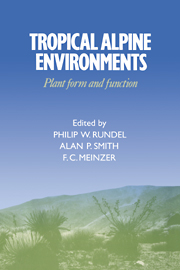Book contents
- Frontmatter
- Contents
- List of contributors
- Preface
- 1 Introduction to tropical alpine vegetation
- 2 Tropical alpine climates
- 3 Páramo microclimate and leaf thermal balance of Andean giant rosette plants
- 4 Comparative water relations of tropical alpine plants
- 5 Cold tolerance in tropical alpine plants
- 6 Anatomy of tropical alpine plants
- 7 Environmental biology of a tropical treeline species, Polylepis sericea
- 8 Morphological and physiological radiation in páramo Draba
- 9 Sediment-based carbon nutrition in tropical alpine Isoetes
- 10 Functional significance of inflorescence pubescence in tropical alpine species of Puya
- 11 Turnover and conservation of nutrients in the pachycaul Senecio keniodendron
- 12 Soil nutrient dynamics in East African alpine ecosystems
- 13 An overview of the reproductive biology of Espeletia (Asteraceae) in the Venezuelan Andes
- 14 Population biology of Mount Kenya lobelias
- 15 Population biology of Senecio keniodendron (Asteraceae), an Afroalpine giant rosette plant
- 16 Population dynamics and flowering in a Hawaiian alpine rosette plant, Argyroxiphium sandwicense
- 17 Plant form and function in alpine New Guinea
- 18 Alpine herbivory on Mount Kenya
- 19 Biotic interactions in Hawaiian high elevation ecosystems
- 20 Tropical alpine ecology: progress and priorities
- Index
2 - Tropical alpine climates
Published online by Cambridge University Press: 21 October 2009
- Frontmatter
- Contents
- List of contributors
- Preface
- 1 Introduction to tropical alpine vegetation
- 2 Tropical alpine climates
- 3 Páramo microclimate and leaf thermal balance of Andean giant rosette plants
- 4 Comparative water relations of tropical alpine plants
- 5 Cold tolerance in tropical alpine plants
- 6 Anatomy of tropical alpine plants
- 7 Environmental biology of a tropical treeline species, Polylepis sericea
- 8 Morphological and physiological radiation in páramo Draba
- 9 Sediment-based carbon nutrition in tropical alpine Isoetes
- 10 Functional significance of inflorescence pubescence in tropical alpine species of Puya
- 11 Turnover and conservation of nutrients in the pachycaul Senecio keniodendron
- 12 Soil nutrient dynamics in East African alpine ecosystems
- 13 An overview of the reproductive biology of Espeletia (Asteraceae) in the Venezuelan Andes
- 14 Population biology of Mount Kenya lobelias
- 15 Population biology of Senecio keniodendron (Asteraceae), an Afroalpine giant rosette plant
- 16 Population dynamics and flowering in a Hawaiian alpine rosette plant, Argyroxiphium sandwicense
- 17 Plant form and function in alpine New Guinea
- 18 Alpine herbivory on Mount Kenya
- 19 Biotic interactions in Hawaiian high elevation ecosystems
- 20 Tropical alpine ecology: progress and priorities
- Index
Summary
Historical introduction
Ecological interest in climates of the tropical alpine regions of the world dates back perhaps to the early travels of La Condamine in Ecuador in the mid-19th century, but more dramatically to the remarkable explorations of Alexander von Humboldt in the northern Andes, Central America and Mexico from 1799 to 1804. His contributions to science from these travels, which encompassed geography, biology, geology, climatology, anthropology and other subjects, filled 30 volumes (von Humboldt 1807–39), and had a tremendous influence on the intellectual and economic development of Latin America in the 19th century. No less an authority than Simon Bolivar once remarked, ‘Baron Humboldt did more for the Americas than all of the conquistadors’ (Von Hagen 1948). The scientific studies of von Humboldt served as the foundation of the modern science of biogeography, and his climatological observations in the Andes and on the Mexican volcanoes played a major role in the development of his ideas.
Another notable advance in scientific knowledge of alpine climatology in tropical mountain regions came not from a typical scientist at all but from the noted European alpinist, Edward Whymper. Whymper, who had been the first man to scale the Matterhorn in the Swiss Alps in 1865, came to Ecuador in 1879 to attempt climbs of Chimborazo and other high volcanoes of that region. He was spectacularly successful not only in these ascents, but in the wealth of ecological and climatological data which he collected and published (Whymper 1892).
- Type
- Chapter
- Information
- Tropical Alpine EnvironmentsPlant Form and Function, pp. 21 - 44Publisher: Cambridge University PressPrint publication year: 1994
- 40
- Cited by

